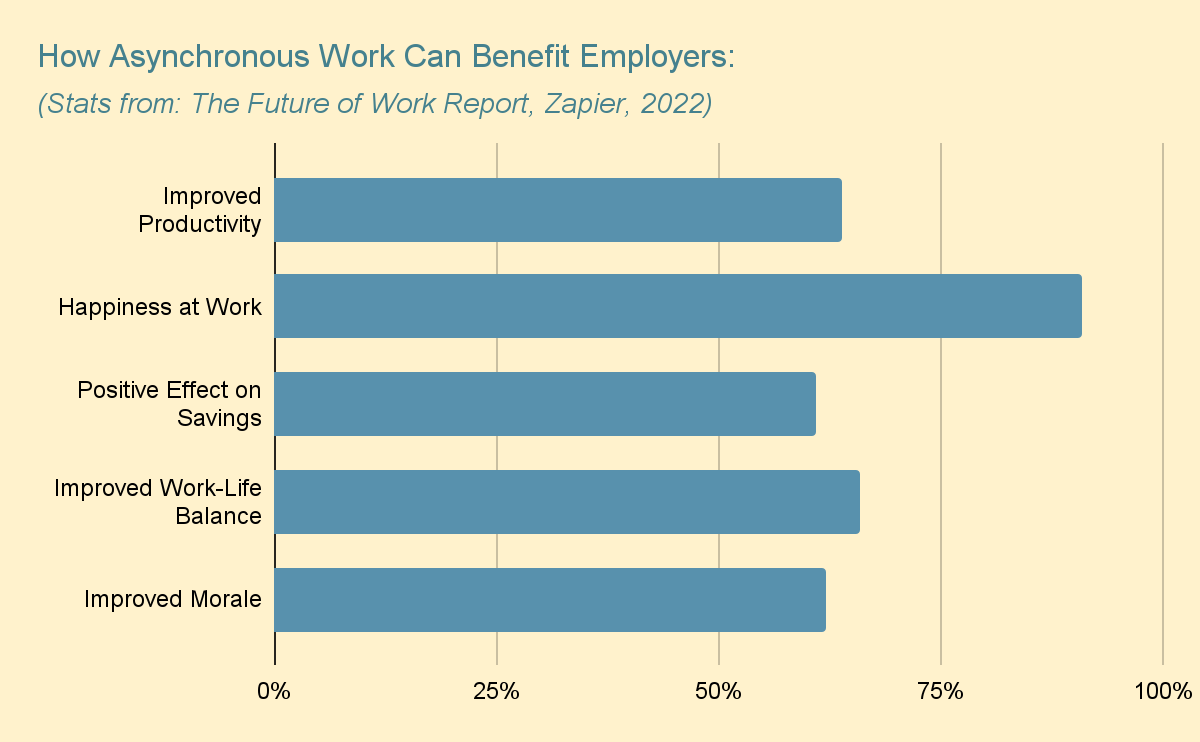
What is asynchronous work and why is it growing in popularity?
Asynchronous work refers to a work style where team members don't need to be present or
collaborate in real-time to accomplish tasks or projects. Instead, individuals work
independently at their own pace and preferred times, communicating through channels like
email, messaging apps, or project management tools. It contrasts with synchronous work,
which requires simultaneous interaction.
The popularity of asynchronous work is on the rise due to several factors. The
Coronavirus crisis, especially the shift to remote collaboration, has prompted companies to
adopt more flexible work arrangements. This shift has given rise to innovative ways of
collaborating, communicating, and working.
The benefits of asynchronous work have contributed to its growing popularity:
- Flexibility: Asynchronous work allows team members to work when they are most productive, enhancing efficiency and work-life balance.
- Global Collaboration: It enables teams spread across different time zones to work effectively without needing to be online simultaneously.
- Focus Time: Reduced immediate responses and constant communication enable deep focus on complex tasks, enhancing productivity.
- Inclusivity: Asynchronous communication ensures everyone's equal participation, irrespective of communication style or seniority.
- Reduced Stress: It decreases stress caused by the need for constant availability and immediate responses.
- Enhanced Documentation: Asynchronous work encourages written communication and documentation, leading to better knowledge sharing and tracking.
Given the desire for continued remote work even after the pandemic, many organisations are recognizing the long-term benefits of asynchronous work in terms of productivity, employee satisfaction, and effective global collaboration.

How does asynchronous communication work and what considerations are important when using it?
Asynchronous communication involves sending messages or information without the expectation of an immediate response. This communication style is well-suited for remote or distributed teams, allowing members to collaborate effectively regardless of time zone differences. Here's how it works and some important considerations:
How Asynchronous Communication Works:
- Message Sending: In asynchronous communication, you send a message, document, or task to a colleague or team member without expecting them to respond immediately.
- Response Time: Unlike synchronous communication, where immediate responses are expected, asynchronous communication allows recipients to reply when it's most convenient for them, without interruption to their ongoing tasks.
- Channels: Asynchronous communication can take place through various channels, such as emails, messaging apps, project management tools (Asana, Trello, Wrike, Slack), or shared documents.
Considerations for Asynchronous Communication:
- Clear Expectations: Establish clear guidelines for response times. Let team members know how quickly they can expect a response to their messages, preventing misunderstandings and setting communication expectations.
- Thoroughness: Since back-and-forth exchanges are minimised in asynchronous communication, ensure that your initial message is detailed and complete, addressing all necessary points to minimise follow-up questions.
- Documentation: Emphasise documentation. Written communication is key in asynchronous communication, as it ensures all important information is recorded and accessible to team members, including those in different time zones.
- Tools: Choose the right tools that facilitate asynchronous communication, such as email, project management software, and collaborative platforms. Make sure these tools are user-friendly and accessible to everyone.
- Respect Time Zones: If working across time zones, be considerate of colleagues' working hours. Avoid sending messages during their off-hours, and set expectations that responses are not expected immediately.
- Priority Communication: While asynchronous communication is effective for most situations, some instances require immediate attention. Clearly define which situations merit synchronous communication, and when to use it.
- Transitioning to Synchronous: In some cases, transitioning to synchronous communication might be necessary. Use tools that facilitate smooth transitions, like scheduling tools for virtual meetings, and ensure everyone is clear on the agenda and goals.
- Building Trust: Asynchronous communication requires a level of trust among team members. Trust that colleagues will respond in a reasonable time frame and that work is progressing as intended.
- Balancing Synchronous and Asynchronous: While asynchronous communication is valuable, remember that some situations, like urgent issues or complex discussions, may benefit from synchronous communication. Finding the right balance is crucial.
- Cultural Sensitivity: Be aware of cultural norms and time zones when communicating asynchronously. Respect different work schedules and holidays.
By adopting these considerations, organisations can harness the benefits of asynchronous communication while maintaining effective collaboration and a healthy work environment.
| Aspect | Synchronous Work | Asynchronous Work |
|---|---|---|
| Interaction Speed | Real-time interaction; immediate responses. | Interaction occurs without immediate responses; delays are expected. |
| Collaboration Timing | All parties engage simultaneously. | Participants engage at their preferred times, accommodating different schedules. |
| Communication Channels | Video calls, phone calls, instant messaging. | Emails, messaging apps, project management tools, shared documents. |
| Focus and Deep Work | Limited due to constant interruptions. | Facilitates deep work, allowing for uninterrupted focus on tasks. |
| Global Collaboration | Challenging due to time zone differences. | Enables collaboration across time zones, promoting global teamwork. |
| Documentation | Conversations may not be fully documented. | Encourages written communication, leading to comprehensive documentation. |
| Decision-Making | Immediate decisions can be reached. | Decision-making may take longer due to asynchronous nature. |
| Response Pressure | Expectation for quick responses. | Reduced pressure for immediate responses, promoting work-life balance. |
| Team Bonding | Supports team bonding through real-time interactions. | Bonding relies on shared objectives and asynchronous communication. |
| Communication Style | Requires simultaneous verbal interaction. | Allows for written communication, accommodating various styles. |
| Emergency Situations | Suitable for urgent matters and crises. | May not be ideal for immediate crisis management. |
| Flexibility | Less flexibility due to real-time constraints. | Promotes flexibility by allowing individuals to work at their pace. |
| Complex Discussions | Supports real-time brainstorming and discussions. | Can accommodate thorough thought before responding to complex topics. |
How does async work generate significant amounts of data, and why is this data valuable for organisations?
Asynchronous work generates significant amounts of data through the interactions, communications, and collaborations that occur within digital tools and platforms. This data is valuable for organisations for several reasons:
- Clear Expectations: Establish clear guidelines for response times. Let team members know how quickly they can expect a response to their messages, preventing misunderstandings and setting communication expectations.
- Thoroughness: Since back-and-forth exchanges are minimised in asynchronous communication, ensure that your initial message is detailed and complete, addressing all necessary points to minimise follow-up questions.
- Communication Records: Asynchronous work relies on written communication through emails, messaging apps, and project management tools. These written exchanges are automatically documented, creating a trail of communication that can be referred back to. This documentation is a valuable source of information for understanding decisions, clarifying instructions, and resolving disputes.
- Project Tracking: When teams collaborate asynchronously, they often use project management tools to assign tasks, set deadlines, and track progress. These tools generate data on project timelines, task completion rates, and bottlenecks. This data helps teams understand their workflow efficiency and make informed decisions on resource allocation.
- Collaboration Platforms: Asynchronous collaboration platforms like shared documents, wikis, and knowledge bases accumulate a wealth of information over time. These resources capture insights, strategies, and solutions to various challenges. This repository of knowledge supports onboarding new team members, reducing redundant work, and promoting a culture of learning.
- Response Times and Patterns: Within asynchronous communication, data on response times and patterns can be analysed. This data can reveal individuals' working habits, their peak productive hours, and how different time zones affect collaboration. Understanding these patterns can help teams optimise their workflows and scheduling.
- Engagement Metrics: In asynchronous collaboration tools, engagement metrics such as document views, edits, and comments can be tracked. These metrics provide insights into which content is most relevant to the team, which areas are being actively worked on, and which may require more attention.
- Task Dependencies: In project management tools, data on task dependencies and handoffs can be captured. This information shows how tasks are interconnected and which ones are blocking others. Analysing these dependencies helps streamline processes and prevent bottlenecks.
- Communication Trends: Analysing communication data can reveal trends in how different teams or individuals communicate. Are there patterns in the type of content discussed, the frequency of communication, or the preferred channels? These insights can guide communication strategies and improve efficiency.
- Process Analysis: Asynchronous work allows for a deeper analysis of processes. By reviewing the documented interactions, organisations can identify inefficiencies, areas for improvement, and opportunities for automation.
- Feedback and Iteration: Through asynchronous communication, feedback is often exchanged in written form. This feedback data can be analysed to understand common issues, recurring suggestions, and areas where products or processes can be enhanced.
- Decision History: The data generated from asynchronous discussions and decision-making processes can be stored and referenced. This historical data allows organisations to track the evolution of decisions and learn from past experiences.
In essence, the data generated by asynchronous work becomes a valuable resource for optimising productivity, improving collaboration, making informed decisions, and fostering a culture of continuous improvement. Organisations can leverage this data to refine their processes, enhance employee experiences, and drive innovation.
According to Statista, “As of the second quarter of 2022, Microsoft accounted for nearly 40 percent of the global unified communications and collaboration market. In 2021, companies’ main IT investment priorities to support WFH were cloud-enabled technologies and digital collaboration tools. Despite the many advantages of video conferencing software, improvements still need to be made, as remote work is rapidly turning into the new standard set-up. By the end of 2022, companies switched their approach from enabling home office, to securing it.”

How can Slack, Loom, and Miro be used effectively for asynchronous communication and task management?
Slack, Loom, and Miro can be used effectively for asynchronous communication and task management in various ways:
Slack:
- Channel Organization: Create different channels based on projects, teams, or topics. This helps keep discussions focused and easily searchable.
- Threaded Conversations: Use threaded conversations within channels to keep discussions organised and prevent clutter. This allows for in-depth discussions without disrupting the main conversation flow.
- Notifications: Adjust notification settings to ensure that team members are alerted only to important messages, reducing unnecessary interruptions.
- Document Sharing: Share documents, files, and links in channels, making it easy for team members to access and collaborate on relevant materials.
- Status Updates: Utilise status updates to let team members know your availability and focus for the day, reducing the need for immediate responses.
- Integrations: Integrate Slack with other tools such as project management software or document repositories to streamline workflows.
Loom:
- Video Updates: Use Loom to create asynchronous video updates. Instead of scheduling meetings, record video messages to share updates, provide explanations, or deliver feedback.
- Training and Onboarding: Create video tutorials for onboarding new team members or explaining complex processes. These videos can be watched at the team members' convenience.
- Project Documentation: Record video walkthroughs of projects, processes, or tasks. This documentation can be shared with team members for reference.
- Collaborative Review: Use Loom to capture and share feedback on documents, designs, or prototypes. This ensures clear communication and avoids misunderstandings.
- Global Collaboration: Utilise status updates to let team members know your availability and focus for the day, reducing the need for immediate responses.
- Integrations: Loom is especially useful for teams spread across different time zones. Team members can watch and respond to videos whenever it suits their schedule.
Miro:
- Visual Collaboration: Miro offers virtual whiteboards that allow teams to collaborate visually. Use it for brainstorming sessions, strategy mapping, or agile ceremonies.
- Project Planning: Create visual project plans, flowcharts, or timelines. These visual aids can be easily shared with team members for feedback and collaboration.
- Workshops and Retrospectives: Miro is excellent for remote workshops, retrospectives, and other collaborative activities that require visual interaction.
- Interactive Walkthroughs: Miro's Talktrack feature allows you to record interactive video and audio walkthroughs of your boards. This is useful for asynchronous explanations and presentations.
- Documenting Discussions: Use Miro to capture discussions, decisions, and ideas visually. This documentation helps in knowledge sharing and information retention.
- Feedback Gathering: Create visual boards for collecting feedback on designs, prototypes, or projects. Team members can contribute their thoughts asynchronously.
Incorporating these tools into your workflow requires clear guidelines on when to use each tool and how to structure communication. It's important to strike a balance between synchronous and asynchronous communication, using these tools to reduce interruptions, improve collaboration, and enhance overall productivity.
How can companies strike a balance between synchronous and asynchronous communication, and what strategies can be employed to prioritise and implement more asynchronous communication habits while still recognizing the need for synchronous communication?
Striking a balance between synchronous and asynchronous communication is crucial for effective collaboration. While synchronous communication offers real-time interaction, asynchronous communication provides flexibility and focus. Here's how companies can achieve this balance and prioritise asynchronous communication while still recognizing the need for synchronous interaction:
- Establish Communication Guidelines:
- Clearly define scenarios that warrant synchronous communication, such as urgent matters or complex discussions requiring immediate feedback.
- Encourage teams to default to asynchronous communication for routine updates, information sharing, and non-urgent matters.
- Educate Teams:
- Train employees on the benefits of asynchronous communication, such as reduced interruptions, improved focus, and increased productivity.
- Share best practices for using asynchronous tools effectively and efficiently.
- Use the Right Tools:
- Implement asynchronous communication tools like Slack, email, Loom, and Miro to facilitate information sharing and collaboration without real-time constraints.
- Reserve synchronous tools like video conferencing for discussions that require immediate interaction.
- Set Expectations:
- Establish response time expectations for different communication channels. For instance, Slack messages might have a longer response window than urgent emails.
- Educate team members that immediate responses aren't always necessary for asynchronous communication.
- Implement Regular Check-ins:
- Hold scheduled asynchronous check-ins where team members provide updates on their progress, challenges, and plans. This eliminates the need for constant real-time updates.
- Designate Quiet Hours:
- Encourage team members to set periods of "quiet hours" when they focus on deep work without responding to messages. This boosts productivity and minimises interruptions.
- Use Time Zones Wisely:
- Leverage time zone differences to create a natural gap between communication cycles. Design workflows that allow team members to work on tasks and receive feedback asynchronously.
- Document Discussions:
- Encourage the use of collaborative platforms like Google Docs or project management tools to document discussions and decisions. This makes information accessible to everyone without real-time engagement.
- Prioritise Synchronous for Complex Conversations:
- Reserve synchronous communication for complex discussions, brainstorming sessions, and real-time problem-solving that benefit from immediate interaction.
- Model Leadership Behavior:
- Leaders should model asynchronous communication habits by sending non-urgent messages during work hours and respecting team members' focus time.
- Foster Trust:
- Build a culture of trust where employees feel comfortable stepping away from real-time communication without fear of missing out or facing consequences.
- Regularly Evaluate and Adapt
- Continuously assess the effectiveness of the communication strategies. Seek feedback from teams and make adjustments as needed to ensure a productive balance.
Remember, the key is to prioritise asynchronous communication for routine tasks, updates, and collaboration while reserving Asynchronous communication for situations where immediate interaction adds value. By implementing these strategies and fostering a culture that values both approaches, companies can harness the benefits of both synchronous and asynchronous communication styles.

Conclusion
In a rapidly evolving work landscape, mastering the art of asynchronous communication and collaboration has become an essential skill for businesses. Asynchronous work, characterised by its flexibility, focus, and global reach, offers numerous benefits that contribute to increased productivity, improved work-life balance, and effective remote collaboration. Embracing tools like Slack, Loom, and Miro enables seamless asynchronous communication and task management, providing the space for deep work and minimising interruptions. However, the balance between synchronous and asynchronous communication remains vital. While asynchronous communication empowers individuals to work autonomously, synchronous interaction fosters real-time problem-solving and team bonding. Striking this equilibrium requires clear communication guidelines, education, and a thoughtful choice of tools.
final thought


by Marketing Team
final thought

